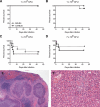Pathogenicity of high-dose enteral inoculation of Burkholderia pseudomallei to mice
- PMID: 21036839
- PMCID: PMC2963971
- DOI: 10.4269/ajtmh.2010.10-0306
Pathogenicity of high-dose enteral inoculation of Burkholderia pseudomallei to mice
Abstract
Melioidosis is a frequently lethal tropical infection caused by the environmental saprophyte Burkholderia pseudomallei. Although transcutaneous inoculation and inhalation are considered the primary routes of infection, suggestive clinical evidence implicates ingestion as a possible alternative route. We show that in BALB/c and C57BL/6 mice, direct gastric inoculation of high doses of B. pseudomallei causes systemic infection that may be lethal or cause chronic disseminated infection. Mice may shed bacteria in the stool for weeks after infection, and high titers of B. pseudomallei-specific IgG are detectable. This report of enteric murine melioidosis supports further consideration of this route of infection.
Figures

Similar articles
-
Murine pulmonary infection and inflammation induced by inhalation of Burkholderia pseudomallei.Int J Exp Pathol. 2012 Dec;93(6):421-8. doi: 10.1111/j.1365-2613.2012.00842.x. Int J Exp Pathol. 2012. PMID: 23136994 Free PMC article.
-
Use of a safe, reproducible, and rapid aerosol delivery method to study infection by Burkholderia pseudomallei and Burkholderia mallei in mice.PLoS One. 2013 Oct 2;8(10):e76804. doi: 10.1371/journal.pone.0076804. eCollection 2013. PLoS One. 2013. PMID: 24098563 Free PMC article.
-
Role for the Burkholderia pseudomallei capsular polysaccharide encoded by the wcb operon in acute disseminated melioidosis.Infect Immun. 2009 Dec;77(12):5252-61. doi: 10.1128/IAI.00824-09. Epub 2009 Sep 14. Infect Immun. 2009. PMID: 19752033 Free PMC article.
-
Interaction between Burkholderia pseudomallei and the host immune response: sleeping with the enemy?J Infect Dis. 2005 Nov 15;192(10):1845-50. doi: 10.1086/497382. Epub 2005 Oct 7. J Infect Dis. 2005. PMID: 16235187 Review.
-
The molecular and cellular basis of pathogenesis in melioidosis: how does Burkholderia pseudomallei cause disease?FEMS Microbiol Rev. 2009 Nov;33(6):1079-99. doi: 10.1111/j.1574-6976.2009.00189.x. Epub 2009 Aug 5. FEMS Microbiol Rev. 2009. PMID: 19732156 Review.
Cited by
-
Particle size and pathogenicity in the respiratory tract.Virulence. 2013 Nov 15;4(8):847-58. doi: 10.4161/viru.27172. Epub 2013 Nov 13. Virulence. 2013. PMID: 24225380 Free PMC article. Review.
-
Genome-scale analysis of the genes that contribute to Burkholderia pseudomallei biofilm formation identifies a crucial exopolysaccharide biosynthesis gene cluster.PLoS Negl Trop Dis. 2017 Jun 28;11(6):e0005689. doi: 10.1371/journal.pntd.0005689. eCollection 2017 Jun. PLoS Negl Trop Dis. 2017. PMID: 28658258 Free PMC article.
-
Activities of daily living associated with acquisition of melioidosis in northeast Thailand: a matched case-control study.PLoS Negl Trop Dis. 2013;7(2):e2072. doi: 10.1371/journal.pntd.0002072. Epub 2013 Feb 21. PLoS Negl Trop Dis. 2013. PMID: 23437412 Free PMC article.
-
Characterization of the Burkholderia pseudomallei K96243 capsular polysaccharide I coding region.Infect Immun. 2012 Mar;80(3):1209-21. doi: 10.1128/IAI.05805-11. Epub 2012 Jan 17. Infect Immun. 2012. PMID: 22252864 Free PMC article.
-
Persistent gastric colonization with Burkholderia pseudomallei and dissemination from the gastrointestinal tract following mucosal inoculation of mice.PLoS One. 2012;7(5):e37324. doi: 10.1371/journal.pone.0037324. Epub 2012 May 18. PLoS One. 2012. PMID: 22624016 Free PMC article.
References
-
- White NJ. Melioidosis. Lancet. 2003;361:1715–1722. - PubMed
-
- Inglis TJ, Garrow SC, Adams C, Henderson M, Mayo M. Dry-season outbreak of melioidosis in western Australia. Lancet. 1998;352:1600. - PubMed
-
- Currie BJ, Mayo M, Anstey NM, Donohoe P, Haase A, Kemp DJ. A cluster of melioidosis cases from an endemic region is clonal and is linked to the water supply using molecular typing of Burkholderia pseudomallei isolates. Am J Trop Med Hyg. 2001;65:177–179. - PubMed
Publication types
MeSH terms
Substances
Grants and funding
LinkOut - more resources
Full Text Sources

